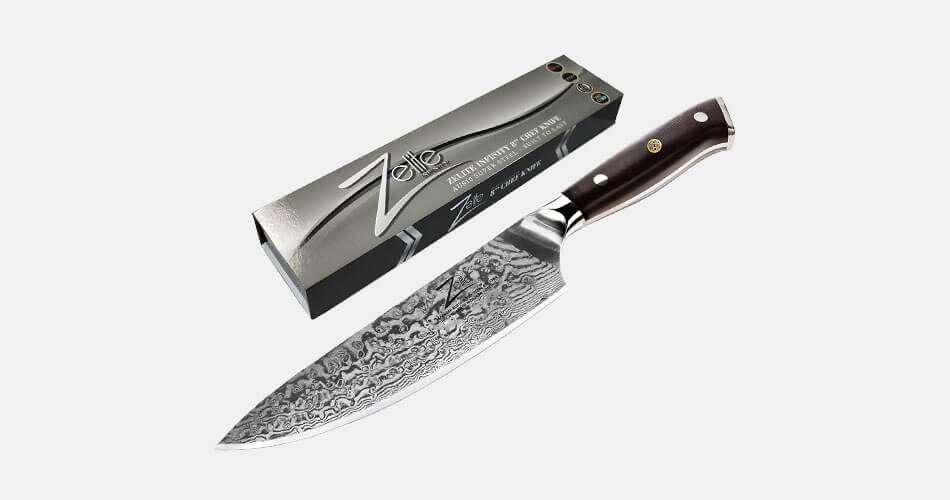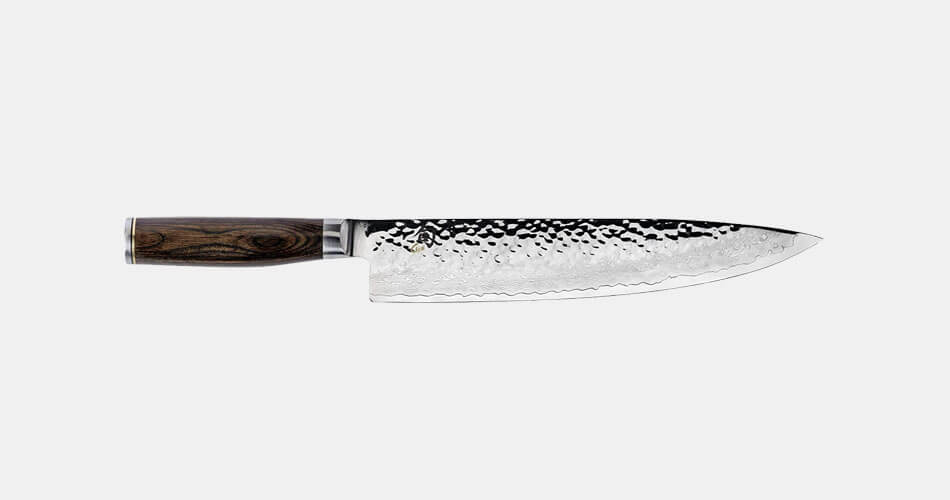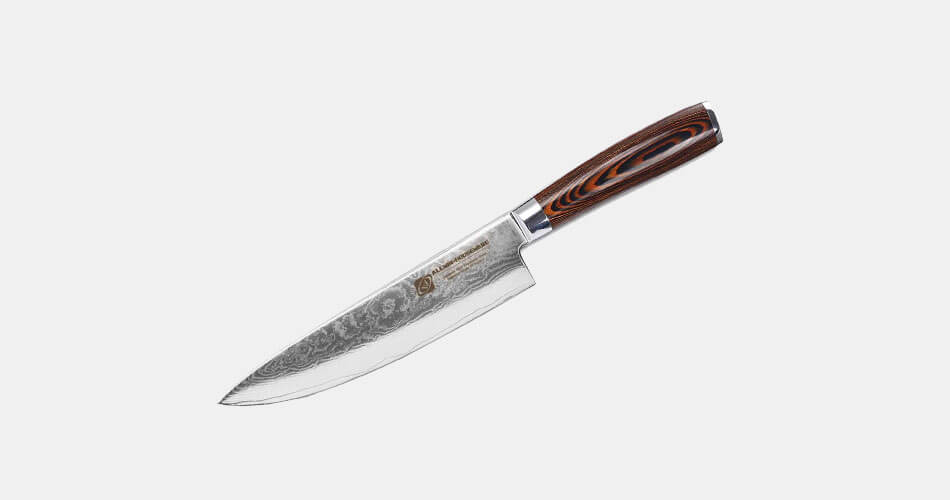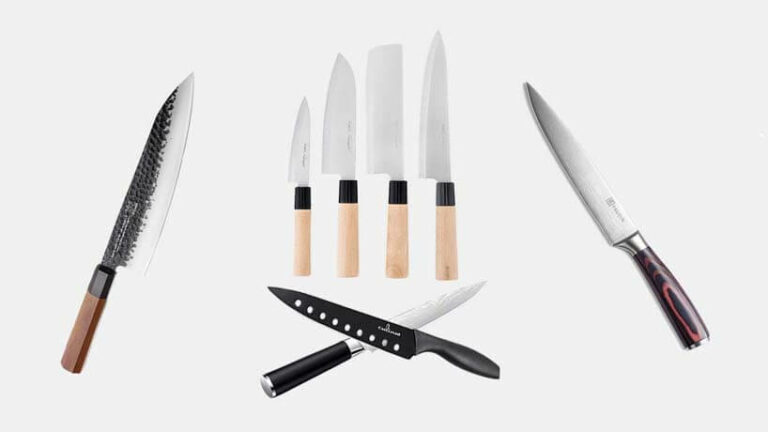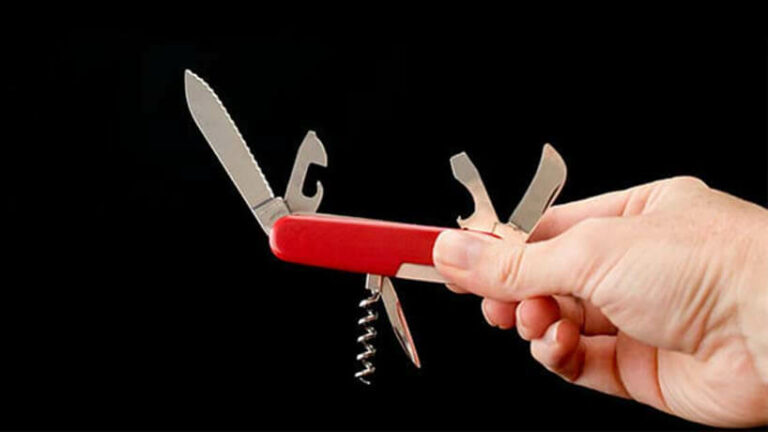Any seasoned chef can tell you how essential their knives are for their craft. The best Damascus chef knife can take your culinary skills to new heights. You’re going to need to finest tools if you want to create something that turns heads and demands attention!
You don’t want to fall short of your potential just because you don’t have the right knives to get you there. Our guide takes the guesswork out of finding the perfect knife for your needs. You’ll find in-depth, accurate, and helpful guidance to make sure you get excellent quality and performance.
10 Best Damascus Chef Knives that Unleash Your Potential
If you want to improve, choosing the right knife for you is essential. They might all seem similar to a layman, but some subtleties can make or break the results you get. We’ve gone through countless options to bring you the best of the best.
Your needs and style are important, and this list caters to a bunch of different ones. Let’s take a look at the 10 knives that go above and beyond to deliver exquisite performance and handling that has a lasting impression. Here are our top picks!
Top 10 Best Damascus Chef Knife Reviews in 2023
DALSTRONG’s Shogun Series Chef Knife
Damascus blades have a long history and over a thousand years of continual improvement and fine-tuning. This chef knife is the embodiment of that development. It has been exquisitely designed and the attention to detail is impeccable. It’s extremely comfortable to hold and doesn’t slide when held with wet hands.
You’ll find the blade to be excellently balanced and seemingly weightless when you’re cutting with it. It holds its sharpness for longer than you’d expect. This knife has struck the balance between weight and handling perfectly. It’s a great tool for the serious chef and complements a skilled set of hands.
- Stunning engravings give the knife a polished and powerful appearance
- 8-degree to 12-degree blade is expertly balanced and butter-smooth to cut with
- The non-porous handle doesn’t slip and slide (made from military-grade materials)
- A sloped bolster lets you get a safer grip on close cuts
- It’s not as sharp as some similarly priced blades
- The finish on the handle will fade and wears over time – you might need to have it redone after a while
Zelite Infinity Chef Knife
If you spend a lot of time in the kitchen, then you’ve probably got a blister from having to wield a knife like a sword. This knife is a good solution if you blister easily. You’ll be able to slice through raw chicken, 3+ layers of bacon, and vegetables with ease. You won’t have to grip the knife like an ax and your forearm isn’t going to seize up after a couple of minutes.
It handles almost all cuts effortlessly and you can plow through tough meats quickly. You’ll save time and won’t have to worry about getting tired or getting blisters. The design is gorgeous and resistant to wear, discoloration, and stains. It still looks pristine long after you’ve bought it.
- Hand-sharpened for effortless cuts
- Gorgeous Damascus design is resistant to corrosion, staining, and losing color
- Awesome discounts when you purchase over 3 or 5 knives at a time
- The handle is military-grade and one of the best-designed ergonomic grips I’ve used
- You need the skills to use this knife to its full potential
- Beginners will struggle to sharpen this knife to its original level of sharpness
Mosfiata Professional Chef Knife
Here’s a fantastic entry into the premium knife market. It’s a great fit for using around your home and gives you a taste of the tools a professional chef would have. Though it’s not designed for professional chefs, it’ll help you to start getting some of the results that they do.
You’ve got everything you’d expect from a high-grade premium knife (such as anti-corrosions and discoloration, Damascus finish) packed into an ergonomically designed knife with excellent balance. The best part of this is the price.
All this performance is very affordable. Considering the price, it’s hard to ignore having this knife (or the set) around the house. It’s one of the most affordable picks for the best Damascus chef knife.
- Premium features and design for a budget price
- Well balanced blade with ergonomic design
- 14-16 degree angle of the blade gives you the heft you need to cut through tougher food and meats
- Doesn’t take a toll on your forearm and hand muscles
- Long term durability is questionable
- Only really for entry-level chef work and home use
Shun Cutlery Chef Knife
Despite the large 10” blade size, this knife isn’t nearly as heavy and bulky as you’d expect. It feels light and balanced in your hand. I find that I’m far more productive with these larger blade sizes as they keep my knuckles above the cutting board and help me to transfer the meat into a tray (on the side of the blade).
If you handle and work with larger quantities of meats/foods, then this Shun knife is more than capable enough to use frequently. It has a classy look and feel. Japanese handcrafted blades like this don’t come cheap, and neither does this. The quality and beauty are jaw-dropping and the performance matches it.
- Pakkawood handle is very resistant to bacteria and stays cleaner than many other knives’ handles
- Handcrafted in Japan over a 100+ step process to ensure supreme quality
- Cutting is effortless and perfect for getting through large quantities
- Extremely durable handle that’s bacteria resistant for commercial use
- The price is higher than most others on this list
- The steel use is exceptionally hard (hence the sharpness) but quite brittle as a result, so take good care of it
Allwin-Houseware Damascus Chef Knife
Here’s another super-affordable entry-level chef knife. It’s very lightweight and excels with basic kitchen work. The double-beveled blade is very sharp but has to be sharpened very carefully to avoid getting any nicks. A round handle makes it easy to grip with either hand, though it’s better for right-handers.
You’ll struggle to cut through thick sinew and boney meat (but that’s not really what this knife is meant for). If you’re looking to save money and still get a knife with premium features and good performance, this might be the best Damascus chef knife to go for.
- Tempting price point and balance between performance and cost-savings
- Lightweight and easy to hold in both hands thanks to the rounded grip
- Very sharp double-beveled blade
- Buzzes through light kitchen work faster than you’d expect – it’s great for developing your skills on
- The handle feels a little hollow and offsets the balance of the knife a little
- Not real Damascus steel (though still does what you’d expect from a premium knife)
MAD SHARK Damascus Chef Knife
This Damascus knife is composed of 67 layers of premium composite steel. For such an affordable kitchen tool, it sure is jam-packed with great qualities. While using it, you would definitely feel the superb German quality of the blade. Thanks to the Damascus finish, this knife is frighteningly sharp. In fact, it is capable of passing the “tomato cut test.”
I don’t think I need to tell you that a knife that can cut through tomato skin and make a thin slice is indeed of the utmost quality. The V-shaped, 5 segmented cutting edge is hand sharpened. And while the steel on this knife is soft and might lose its edge after a few sessions, you’ll find that you can quickly put a sharp edge on the blade. Regular honing every 2-3 months also keeps it in shape.
Even professional chefs also use this knife, and they praise that the knife is lightweight yet well balanced. The military-grade G10 handle is fixed by a center engraved rivet, and you don’t need to worry about shrinkage or cracking. It’s very comfortable to grip. While this knife is dishwasher safe, I’d still recommend you hand-wash it carefully if you value its quality. Moreover, while using the finger guard seems like a good idea, it will scratch the blade, so I suggest you work without it.
- Hand sharpened Damascus blade
- The military-grade G10 handle
- Well balanced and lightweight
- Passes the tomato cut test right out of the box
- The blade can’t hold an edge for too long
- Rust-resistance not up to the par
Yoshihiro VG10 Japanese Chefs Knife
This Yoshihiro knife is a versatile pick for the best Damascus kitchen knives. You’ll be able to get through thin-slicing and dicing and then switch over to carving up a turkey right out the oven. This versatility is essential if you’re looking to improve your skills as it helps you develop different techniques with the same blade.
The blade does an excellent job of reducing friction and keeping food from sticking to it. It’s easy and quick to work with. You’ll be able to get a razor-sharp edge by sharpening it yourself. It shapes well and doesn’t take long to get it as sharp as it came in the box. Be sure to keep it dry and out of the sink at all times. It’s a premium Japanese chef knife that needs premium care. Don’t put it in the dishwasher.
- Versatile enough to cover most of your needs in the kitchen
- Quick and easy to work with
- Stain resistance is top of the line and the blade is frictionless
- More suited to entry-level chefs still in their early development
- The handle might split if you don’t care for the knife (hand wash and no dishwashers)
Daddy Chef Damascus Chef’s Knife
It’s well-suited for chopping, dicing and mincing, while still being sharp enough to do some carving and cutting through tough meat. Many knives claim to be usable for both left and right-handed people, but end up with a clumpy dragging feeling while cutting. That’s not an issue with this knife; you’ll be able to use it with your left hand effortlessly.
It’s one of the few knives that cater to ambidextrous chefs. I love the protective box that comes with it. It has a classy and elite look, while still delivering excellent protection against moisture and corrosion.
- Gorgeous wooden box with soft inner lining
- Suitable for easy ambidextrous use
- Lightweight and very easy to hold
- Excellent durability and design considering that it’s
- Damascus design and finish isn’t very pronounced and doesn’t always show – it would be great if it was a little darker
- It’ll struggle to cut through heavy-boned meat
PAUDIN Professional Chef Knife
As far as value for money goes, this might be one of the best Damascus Chef knives. You’re getting the same features and capability that is offered by far more expensive knives. The handle fits in your hand well (even fits larger hands well) and is exceptionally comfortable to hold and cut with.
With a slightly lower hardness rating, it’s slightly less sharp than some of the other knives on this list. This isn’t necessarily a bad thing though, as the lower hardness rating makes the blade less brittle – and far more durable. The design and build of the knife are visually stunning.
- Beautiful handle and Damascus pattern finish
- One of the most comfortable knives if you have larger hands
- Less brittle than most other knives at this price range
- Value for money makes this one of the best options on the market while still offering professional performance
- The gap in the bolster doesn’t look bad – but you’ll feel it immediately if you have experience with these kinds of knives
- A little more challenging than most to keep clean
TUO Damascus Chef’s Knife
This is a heavy-duty knife that excels at slicing through thick vegetables, large fruits, meat with and without bone, and pretty much anything you put before it. It’s heavy in the hand and isn’t easy to wield without putting your back into it. That being said though, it’s exquisitely well-balanced and ergonomic despite its size and weight.
You get through meats and other food with ease – while other similar-sized knives struggle. All this is made even more tempting when you look at the price. It’s on the cheaper side will still taking on knives that cost far more. Overall, you’re getting one of the top options for the best Damascus chef knife for the money.
- Fantastic value for money
- The dragon-keel pattern for the handle is attractive and manages the weight on the knife well
- Doesn’t need to be sharpened often
- Cuts through thick and bone-filled meat with ease
- Might be a bit heavy for someone with a delicate build
- The thickness of the blade makes it tougher to get very thin slices of meat or vegetables
How to Choose the Best Damascus Chef Knife for Your Needs
High-quality chef knives have many common qualities that are non-negotiable. We’ll go over some of the aspects to make sure you’re getting the best value for your money. We’ll also take a look at the best knives that might meet different needs and skillsets. You need a knife that complements your level, style, and goals. Let’s go!
What to Look for in the Best Damascus Chef Knives?
There are a couple of features that you need to carefully think over before committing and buying a knife. This section breaks down what to look for in each of these features, and what’s most important. Here they are:
Blade Angle
This angle refers to the slope the blade follows from where it begins at the handle to the point of the knife. Steeper angles (14-16 degrees) mean larger blades that are better suited to carving and handling thicker foods. They’re generally heavier and harder to handle, so the skill requirement is higher.
Straighter blades (6-10 degrees) tend to be thinner and are better suited to slicing, dicing, and mincing. They’re easier to handle due to their lighter weight and balanced build. Beginners do well with these blades because they’re easier on your arm and hand.
Handle
Other than being a good fit for different hand sizes, handles need to balance the blade as perfectly as possible. You don’t want a blade that’s too light or too heavy, and the handle has a big role in this. It also should be a non-porous material (for moisture resistance) that has a good grip and doesn’t crack over time.
An ergonomic handle and grip are among the most important features to consider if you’re going to be using the knife for long sessions. Your arms and hands will thank you for it. An ergonomic grip can completely change the experience and “feel” of a knife. The final thing to consider is the finish and other aesthetic fillers that match the blade.
The Hardness of the Steel
The key point to remember is that the harder the rating of the steel, the sharper the blade will be. The trade-off is that these hard blades are more brittle and might chip easily.
Going too much over 62+ Rockwell hardness will lend to quite a brittle blade. Going under 60 might mean the blade struggles to keep its sharpness well enough to be used consistently. The sweet spot is between 60-62 Rockwell hardness for best Damascus chef knife.
Tapered Bolster
This is the thickened piece of metal leading from the blade into the handle. It helps to smooth the transition to the knife’s handle, make it easier to hold and more durable. The tapered bolster is an important part of the anatomy of a knife and helps to further counterbalance it for better handling and precision.
Full Tang
You need a knife with a full tang design as it speaks to the quality it was crafted with. Full tang knives have one single metal piece that runs through the knife (the blade and the steel in the handle are one piece). They’re extremely durable and very often superior to other knife builds.
They cost more and a common in premium knife sets. You should consider all of these features, which of them are most important to you, and how they affect the price. Finding this balance will help you buy a knife that performs as you’d expect from a premium knife.
How We Chose the Knives That Made This List
It’s not as simple as throwing a random list of knives together. There are quite a few criteria that the knives need to meet to be considered. Here are the most important aspects we looked at while bringing this list together:
- Sharpness and Brittleness: Harder steel is generally sharper than softer steel, at the cost of being more brittle and easier to break. There are softer steel knives in this list and some hard ones that you can make exquisitely sharp.
- Durability: This refers to the durability of both the steel and the handle. There shouldn’t be too many places on the knife where gunk and dirt can build up, causing corrosion and possibly contaminating your food. The steel should be high-quality and the handle needs to be made from well-treated woods, and given finishes that are bacteria-resistant and moisture resistant.
- Aesthetics: Damascus steel has unique and beautiful finishes on the steel. We’ve picked knives that have unique looks that are genuine and won’t fade over time. We also considered the aesthetics of the handle and how it complements the overall looks of the knife.
- Weight and Ergonomics: This is probably one of the more important aspects of kitchen knives. They need to be super-easy and smooth to use. The knives in our list have excellent balance, ergonomic grips and are suitably heavy for their purpose.
What Are the Differences Between Damascus Knives and Japanese Knives?
The Japanese were among the first to use carbon in their steel. This allows excellent levels of sharpness and a very unique and darkened look to the steel. The main issue with this is carbon steel rusts quite easily, meaning that the supreme sharpness and utility is counter-balanced by having to be ruthless in how you care for your knife.
It needs lots of attention and just takes a little negligence to ruin the knife. Damascus steel on the other is the refinement of centuries of steel-working development. The actual formula for creating real Damascus steel was lost around 200 years ago.
Now Damascus steel is made by folding the steel into itself over and over again. The result is the wavy water-like finish of the steel that can be very sharp. Damascus holds its edge well and is resistant to rust. It’s not as sharp as carbon-steel, but this is the trade-off for improved durability and resistance.
What Are the Different Types of Damascus Kitchen Knives?
If you’re looking to kit yourself out thoroughly and have all your bases covered, you’ll need to know about the different types of knives for your kitchen. Each of them has specialized roles and different strong and weak areas. Here they are:
- Chef’s Knives: This is the most versatile and commonly used knife in the kitchen. They’re probably the most important knife to have in your kitchen and will handle almost all cutting jobs you give it. They range from 6-14” in size.
- Utility Knives: These are smaller than chef’s knives and usually around 4-7”. They’re light and excellent at handling smaller slicing jobs like buns, herbs, vegetables, and sandwiches. They can’t cut bones and loaves of bread due to their smaller size.
- Paring Knives: These small knives range from 3.5-4”, though you can find some smaller ones. They’re used to peel fruits, gutting prawns, taking the seeds out of fruits, and cutting herbs. You can’t use these small blades for cutting meat or tough, large vegetables.
- Vegetable Knives: They’re broad knives that are exclusively used for chopping and slicing vegetables. You won’t find knives that are better at slicing and dicing vegetables and fruits.
- Cleavers: These thick, sharp, and heavy knives are used to chop and prepare meat. They can break and cut through bones and very thick meat. You shouldn’t use them for any kind of delicate or light cutting work.
Frequently Asked Questions (FAQs)
Q: What Is a Damascus Chef Knife?
A: A Damascus knife refers to a knife made through a specific method of melting steel. The process can be traced back to the Middle Eastern smiths’ ancient practice, particularly in Damascus, Syria. The modern method involves melting sheets of steel. They can be welded at first (fabricated) or directly melted on a charcoal oven (cast).
As the sheets are combined, a cycle of folding, hammering, and melting ensues until the material is thin enough to be a blade. The process may be laborious, but it is meant for sturdiness. It is easy to spot a Damascus knife with irregular but aesthetically pleasing patterns on the blade.
Q: What Benefits Can You Get From a Damascus Chef Knife?
A: With numerous layers of steel being forged into a single blade, the result will be a very sturdy knife. If used for kitchen purposes, you can cut anything without worrying about the blade’s strength. Slicing will be a smooth task, and chopping won’t be a problem. Aside from that, you will worry less about the maintenance.
Q: What Features Are to Look at When You Choose a Damascus Chef Knife?
A: If you are looking for a Damascus chef knife, these are the features you need to look out for:
Steel type and layers: The more layers the Damascus blade has, the more durable it could be. VG-10 is a Japanese high-carbon stainless steel that is used to make Damascus chef knives.
Handle construction: With a durable blade, you need a comfortable handle to pair it with. For most kitchen purposes, choose a water-resistant type.
Edge: There are chef knives that cater to left-handed users and ambidextrous users.
Coating: Choose knives with stain-resistant and rust-resistant coating.
Final Thoughts
That’s all for our guide! Well done for taking the time to go through the options we’ve brought before you. Chef’s knives are essential in any serious kitchen, and this is a very important choice. You’ve seen our top overall and top budget picks for the best Damascus chef knife.
Bear in mind that this is our opinion after spending hours going through the options and bringing you the best ones. Ultimately, this is a choice you’ll have to make that’s based on your experience, budget, needs, and style. What matters is that you keep moving forward. Don’t get too caught up in the deciding process.
Go with the choice that feels right for you. Remember that many of these knives have money-back returns that take all the risk away from you. Take what you’ve learned from our guide and make your decision. Once you’ve got the best Damascus chef knife in your kitchen, your experience and skillsets will grow to new heights!



